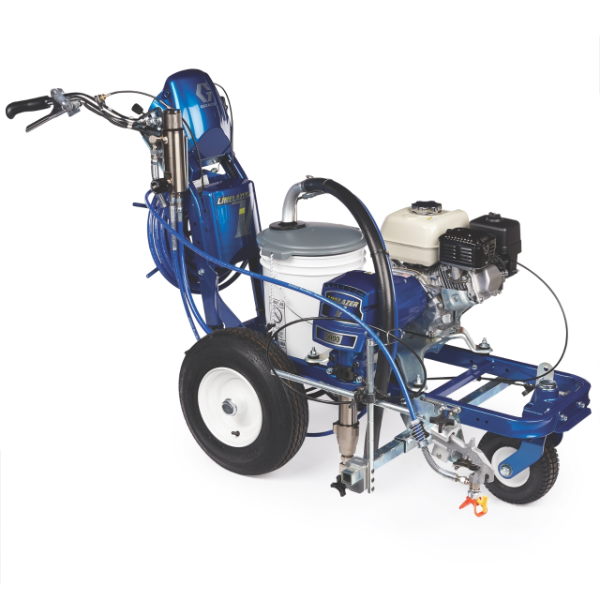5 major line marking challenges for airports
Discover 5 challenges airports face when organising appropriate airport line marking.
Spotless airport line marking is essential for compliance, safety and smooth operation. Keeping up with all the necessary line marking in every area of an airport is a complex endeavour. Read more about the five major challenges it presents to airports.
Whatever their size, airports are busy places with a constant crisscross of people, planes and goods. Proper line marking is a substantial factor in running an airport smoothly. When it’s well executed, you barely notice it’s there. When it’s poorly executed, people or goods get lost, safety is put at risk or compliance is breached. So it pays to do it properly in the first place before maintaining it correctly. What are the five biggest challenges airports face when it comes to line marking?
1. Airport line marking needs to be compliant at all times
On top of regulations issued by international organisations, specific national regulations may apply to line marking. Remaining compliant is one of the main reasons why good-quality line marking is so important. Precise execution and close maintenance are essential. Operators need to be aware of the compliance issues that low-quality work can bring. This also means that proper knowledge of how to operate line marking equipment is crucial.
2. There’s no cutting corners when it comes to safety
It goes without saying that airports must guarantee safety at all times. Top line marking quality increases the safety of passengers and personnel, and allows for safe circulation of cars, utility vehicles and planes. You need line marking to be clear, sharp, in accordance with the specs and as durable as possible, while touch-ups and repairs need to be done quickly. All this requires committed operators using top-quality robust equipment.
3. Continuity of operation enhances profitability
Ensuring compliance and safety is only the first part of the story. Airports need to be profitable as well. Continuity of operation plays a big role in being cost-effective. Sudden repairs or unexpected wear, unavailability of contractors or malfunctioning line marking equipment disturbes smooth operations, as it can cause delays or incidents. Consider acquiring your own equipment and using in-house operators tso you can be more flexible and agile when dealing with planned or unplanned interventions.
4. Keeping track of all the airport lines is complex
Distinctive airport zones have specific line marking needs. There are roads, car parks, taxiways and runways, outdoor and indoor areas, etc. They all have various marking needs. A detailed line marking inventory should list all the types of markings.
- Area information
- Location
- Indoors or outdoors
- Secured or not
- Operational restrictions
- Monitoring & maintenance needs
- How critical is this type of marking for compliance, safety or smooth operations?
- What is the monitoring frequency?
- Level of wear allowed
- Maximum response times in case of emergency
- Application specs
- Colour(s)
- Line, double lines
- Patterns, symbols or templates required
- Safety or health precautions
- Material used (e.g. type of paint, beads)
- Equipment & operators
- Equipment needed
- Accessories and extra materials (e.g. paint) needed
- Who is in charge of executing (e.g. internal maintenance operators, external contractor)?
A detailed inventory allows for more efficient planning and execution of line marking management, which leads us to the next challenge.
5. When not managed efficiently, airport line marking is a mess
Excellent planning, spotless execution and periodic checks are key as they enable lower costs, reduce risks, enhance compliancy and create fewer operational disturbances. The following considerations can help increase efficiency and reduce costs.
- Urgency
Less urgent jobs might not require calling out expensive external contractors at an ‘emergency’ rate. They could instead integrate this job into their less urgent planned maintenance cycles.
- Availability of in-house operators
Some airport maintenance teams are available around the clock, working in shifts. Consider using them for specific or urgent repair jobs while they are ‘on duty’.
- Dedicated equipment
What line marking equipment is available? Is it feasible to invest in proper equipment and at what point will it pay off? Explore the market and discover the quality of dedicated machinery for all kinds of line marking needs.
Maximum control reduces complexity
Managing line marking in all areas of an airport, whatever its size, is not simple. Compliance and safety are crucial as you want to avoid any liabilities. Taking maximum control by getting a clear view of the different needs can reduce the complexity as well as the constant pressure of urgency. A different approach to in- or outsourcing the work and investing in proper equipment are worth considering to overcome some of the challenges you face in managing all your line marking responsibilities.
Related Articles
Why airports should invest in their own line marking equipment
Consider the benefits of investing in proper line marking tools as an airport. It allows you to (partially) have line marking done by your own operators.
How to select the right airport line marking unit
Define what features matter for you when buying an airport line marking unit. Choose what kind of unit makes line marking easier and better quality.
What Graco airport line marking unit fits your needs?
Need outdoor or indoor line marking at your airport? Graco has electric, hydraulic and mechanical line marking units, fit for a multitude of applications.







